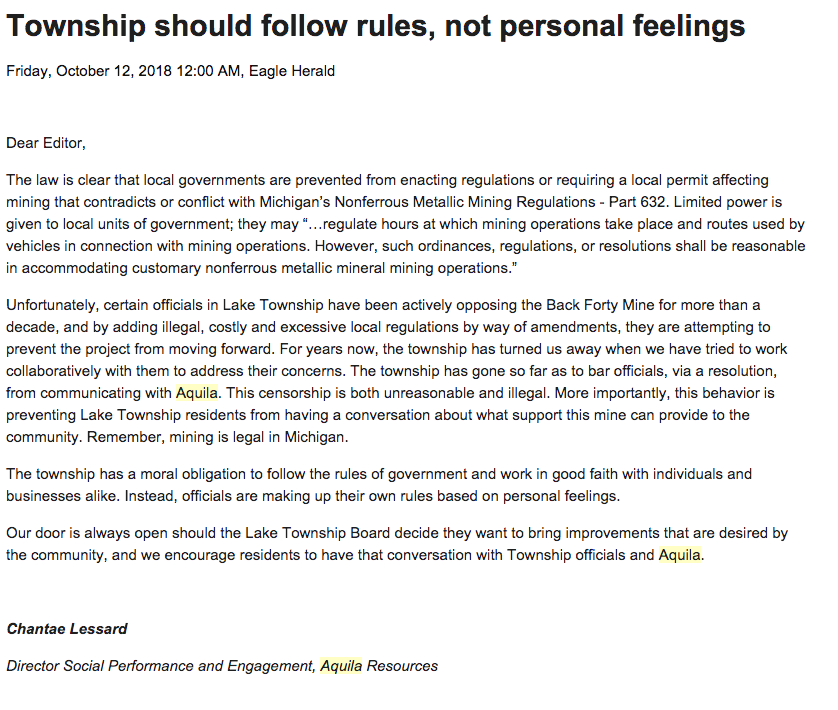By Mark Doremus
Aquila Resources’ stock price has dropped to a 52-week low, despite the fact that state regulators have green-lighted its Back Forty mine west of Stephenson, Michigan.
The stock price has declined 57 percent, to 12 cents a share, since June 4, 2018, when Aquila received its fourth and final state permit for the project.
What’s going on?
The first place to look for an answer is the price of gold and zinc, experts say. Those two minerals make up 82 percent of the Back Forty’s anticipated metals production.
The price of gold is down 10 percent from its 52-week high. So, gold mining companies aren’t feeling an urgent need to seek new supplies, said investment analyst Dave Forest of Pierce Points (
piercepoints.com).
Meanwhile, zinc is down 29 percent from its 52-week high.
The zinc price decline is driven by concerns about a tariff-driven trade war, and a general cooling off of the Chinese economy, which drives much of the market for global minerals, according to Forest and Prof. Gary Campbell, a mining economist with Michigan Technological University in Houghton, Mich.
There is also a general lack of interest in the mining industry among investors, Forest said.
“Financing of mining projects is not a hot area right now,” Forest said. “There are not as many deals being done as there were five or six years ago.”
Aquila says it needs at least $263 million to open the Back Forty, on top of the $90 million it has already spent on planning and permitting. It is looking for a partner with deep pockets to capitalize the open-pit mine and mill.
So far, no one has committed big money to get the project into the construction phase.
The lack of an immediate development deal isn’t fatal for the Back Forty project, Forest said. However, it may have disappointed investors who were hoping the project would move forward as soon as the final permit was issued, and that in turn may have affected the stock price.
Finally, investors may be reacting to the many roadblocks that face the Back Forty project, even though all the permits for the mine have now been issued.
Two administrative challenges to the project have been grinding through the hearings process for almost two years. Both target Aquila’s Back Forty mining permit. Final arguments for those contested cases are being drafted now, and administrative law judge Daniel Pulter could issue a decision before the end of the year.
As those proceedings wind down, however, three additional contested case petitions have been filed on Aquila’s recently-issued wetland permit. The Menominee Indian Tribe of Wisconsin has also challenged the wetland permit in federal court.
And, despite the company’s claims, its permit applications aren’t completely done yet. The site plan in the mining permit must be amended so it matches the layout in the wetland permit. And the wetland permit came with 28 pages of conditions that must be met before the Back Forty gets a final go-ahead from state regulators.
There’s more. Aquila wants to cut a county road that passes through the mine site, but it hasn’t submitted a proposal yet. And Lake Township, where the Back Forty would be located, has implemented zoning-related ordinances that must be addressed at some point, either by negotiations or in a court battle.
These unresolved issues create uncertainty about the prospects for the Back Forty mine. That may be driving investors away from Aquila Resources toward other, more promising investment opportunities.
Aquila Resources did not respond to repeated requests for comment on this report, and has not issued any public statement about its declining stock price.

